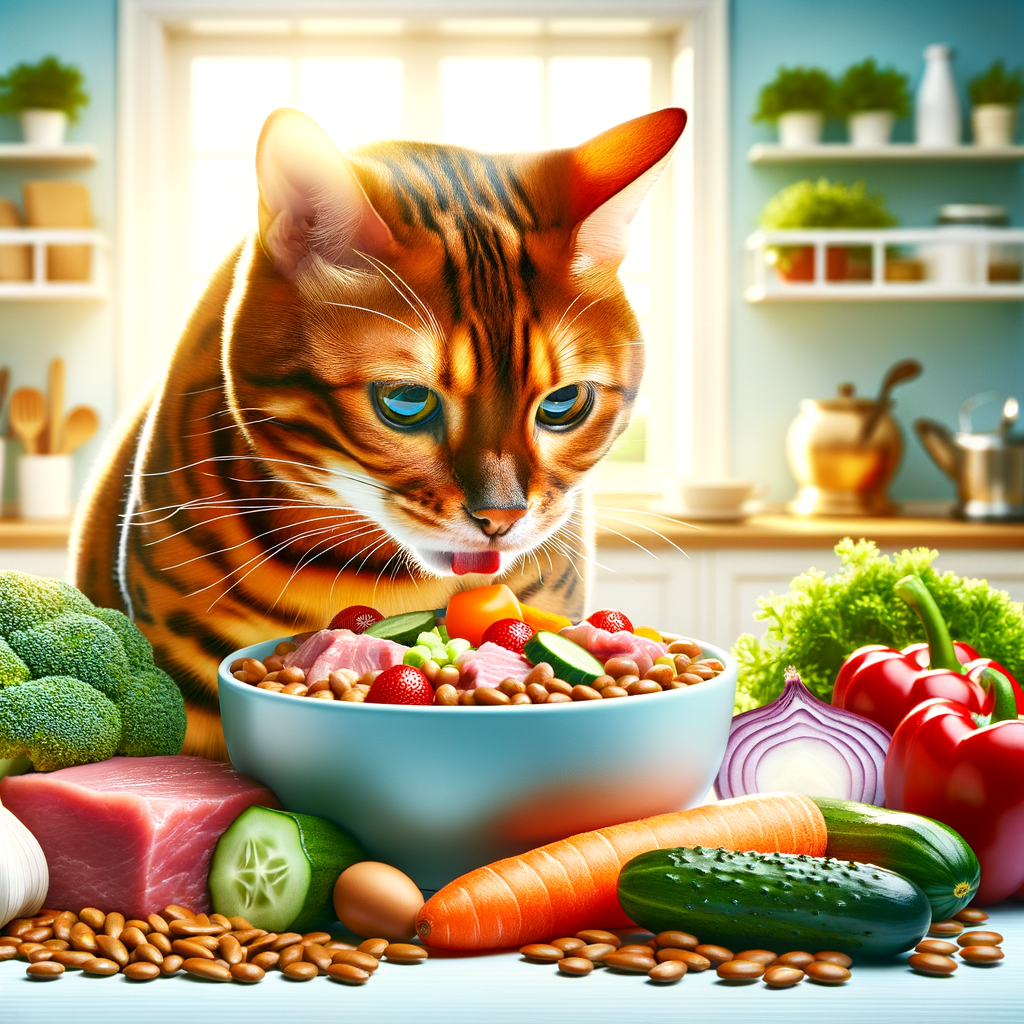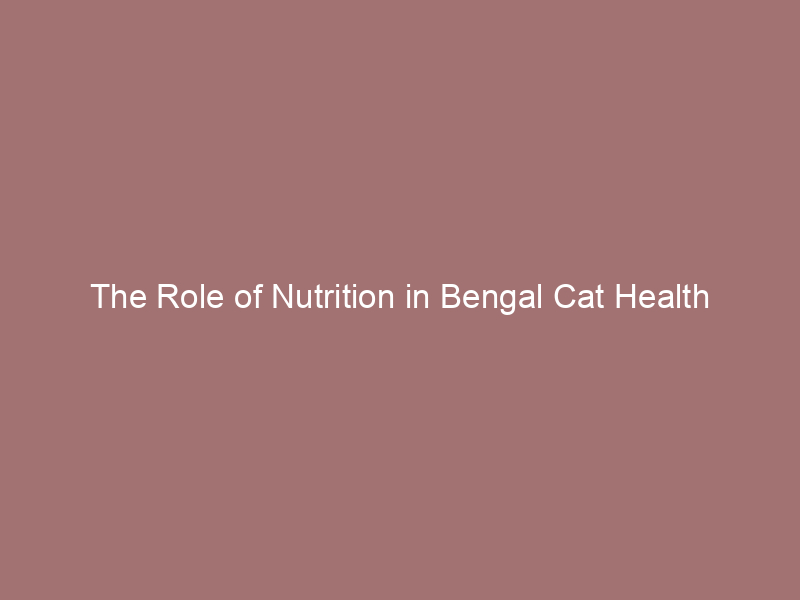
The Importance of Nutrition in Bengal Cat Health
- Understanding the link between Bengal cat diet and health
A well-balanced diet can help prevent many health issues. Just like humans, what Bengal cats eat affects their overall well-being. Feeding them the right food can make a big difference.
For example, a diet rich in protein helps build strong muscles. Bengal cats are active and need lots of energy. Protein gives them the fuel they need to stay playful and healthy. On the other hand, poor nutrition can lead to problems like obesity, diabetes, and heart disease.
- How Bengal cat nutrition impacts longevity and vitality
Good nutrition not only keeps Bengal cats healthy but also helps them live longer. A proper diet can boost their immune system, making them less likely to get sick. It also keeps their coat shiny and their eyes bright.
Studies show that cats with a balanced diet live longer and have fewer health problems. For example, a study by the American Veterinary Medical Association found that cats fed a high-quality diet lived up to 2 years longer than those on a poor diet.
In summary, feeding your Bengal cat the right food is essential. It keeps them healthy, happy, and full of energy. A healthy diet leads to a longer, more vibrant life for your Bengal cat.
Bengal Cat Dietary Needs
Essential Nutrients for Bengal Cats
- Proteins and their significance in a Bengal cat’s dietThey help build muscles and keep the body strong. Bengal cats are active and need more protein than some other cats. Good sources of protein include chicken, fish, and turkey.
- The role of carbohydrates in Bengal cat nutritionCarbohydrates give Bengal cats energy. But, they should not eat too many carbs. Too many carbs can make them gain weight. Healthy carbs come from vegetables and grains like rice.
- Vitamins and minerals: What are they and why are they important?Vitamins like A, B, and E keep their skin and fur nice. Minerals like calcium and phosphorus make their bones strong. Cats can get these from fruits, vegetables, and special cat food.
Healthy Food Choices for Bengal Cats
Commercial Cat Food vs. Homemade Meals
-
Pros and cons of commercial cat food:
- Pros: Convenient, balanced nutrition, long shelf life.
- Cons: Can contain fillers, preservatives, and artificial ingredients.
-
Benefits and drawbacks of homemade meals:
- Benefits: Fresh ingredients, control over quality, no artificial additives.
- Drawbacks: Time-consuming, requires nutritional knowledge, can be expensive.
| Type | Pros | Cons |
|---|---|---|
| Commercial Cat Food | Convenient, balanced nutrition, long shelf life | Can contain fillers, preservatives, and artificial ingredients |
| Homemade Meals | Fresh ingredients, control over quality, no artificial additives | Time-consuming, requires nutritional knowledge, can be expensive |
Bengal Cat Feeding Guide
Feeding Schedule and Portion Sizes
- Understanding the feeding schedule for Bengal catsMost Bengal cats do well with two meals a day. This helps them maintain a healthy weight and keeps their energy levels stable. You can feed them once in the morning and once in the evening.
- How to determine the right portion sizePortion size depends on your cat’s age, weight, and activity level. A general rule is to feed your Bengal cat about 3% of their body weight in food each day. For example, if your cat weighs 10 pounds, they should eat about 0.3 pounds (or 4.8 ounces) of food daily. Always check with your vet to make sure you are feeding the right amount.
Best Nutrition Practices for Bengal Cats
Bengal Cat Food Recommendations
- Top commercial food brands for Bengal cats
Choosing the right food for your Bengal cat is crucial. Here are some top commercial brands:
-
-
- Royal Canin Bengal: Specially formulated for Bengal cats, this brand supports their active lifestyle.
- Blue Buffalo Wilderness: Grain-free and rich in protein, this brand is great for maintaining muscle health.
- Wellness CORE: This brand offers high-protein, grain-free options that are ideal for Bengals.
-
-
Healthy homemade meal recipes
If you prefer making homemade meals for your Bengal cat, consider these healthy recipes:
-
- Chicken and Rice: Cooked chicken breast mixed with rice and a small amount of vegetables like carrots or peas.
- Fish and Sweet Potato: Baked fish (like salmon) combined with mashed sweet potatoes and a sprinkle of parsley.
- Turkey and Pumpkin: Ground turkey cooked with pumpkin puree and a bit of spinach for added nutrients.
Bengal Cat Health Tips
Preventing and Addressing Health Issues Through Diet
- Common health issues in Bengal cats and how diet can helpBengal cats are known for their active and playful nature. However, they can face health issues like obesity, dental problems, and digestive issues. A balanced diet can help prevent these problems.
- Obesity: Overfeeding and lack of exercise can lead to obesity. Feeding your Bengal cat a diet rich in proteins and low in carbohydrates can help maintain a healthy weight.
- Dental Problems: Dental issues can be prevented by providing dry food that helps clean their teeth.
- Digestive Issues: Bengal cats can have sensitive stomachs. A diet with high-quality ingredients and no artificial additives can help avoid digestive problems.
-
Signs of nutritional deficiencies and how to address them
Watch for signs of nutritional deficiencies in your Bengal cat. These signs can include:
- Dull Coat: A lack of essential fatty acids can cause a dull coat. Adding fish oil or omega-3 supplements can help.
- Weakness: Low energy levels can be a sign of insufficient protein. Ensure your cat’s diet includes high-quality protein sources like chicken or fish.
- Weight Loss: Unexplained weight loss can indicate a lack of essential nutrients. Consult your vet to adjust your cat’s diet accordingly.
If you notice any of these signs, consult your veterinarian. They can recommend dietary changes or supplements to address these deficiencies.
Case Study: Bengal Cat Health and Diet
-
Case Study 1: Improving Health Through Diet Adjustments
Meet Luna, a 3-year-old Bengal cat. Luna was often tired and had a dull coat. Her owner decided to change her diet to see if it would help.
First, they switched to high-quality cat food with real meat as the first ingredient. They also added more wet food to her diet to keep her hydrated.
Within a few weeks, Luna’s energy levels improved. Her coat became shiny and soft.
-
Case Study 2: Addressing Food Allergies in Bengal Cats
Max is a 5-year-old Bengal cat who had itchy skin and frequent ear infections. His owner suspected a food allergy.
They tried an elimination diet, removing common allergens like chicken and grains. After a few weeks, Max’s symptoms improved.
They found that Max was allergic to chicken. Now, Max eats a special diet free of chicken, and his skin and ears are much healthier.
Key Takeaways: Bengal Cat Health and Nutrition
-
Understanding the importance of a balanced diet:
It ensures they get all the necessary nutrients to stay active and healthy. A proper diet can prevent many health issues and keep their coat shiny and smooth.
-
Recognizing the signs of nutritional deficiencies:
Look out for symptoms like weight loss, dull coat, and lethargy. If you notice any of these signs, consult your vet immediately.
-
Implementing a healthy feeding schedule:
Establishing a regular feeding schedule helps maintain your Bengal cat’s health. Feed them at the same times each day to regulate their metabolism and prevent overeating.
| Key Aspect | Details |
|---|---|
| Balanced Diet | Ensures all necessary nutrients are provided. |
| Signs of Deficiencies | Weight loss, dull coat, lethargy. |
| Feeding Schedule | Regular feeding times to regulate metabolism. |






